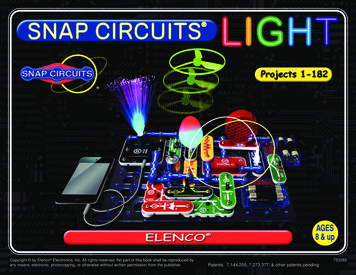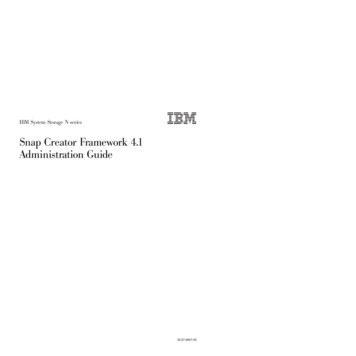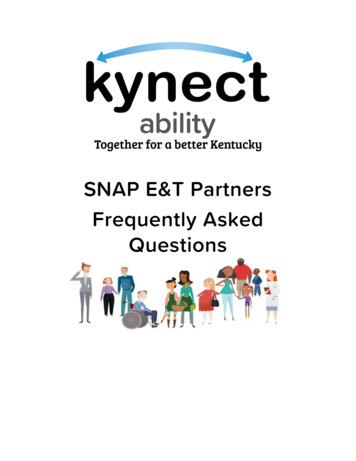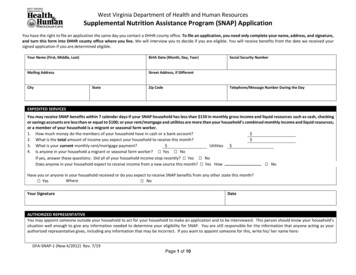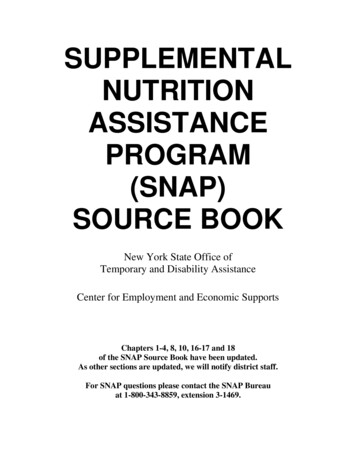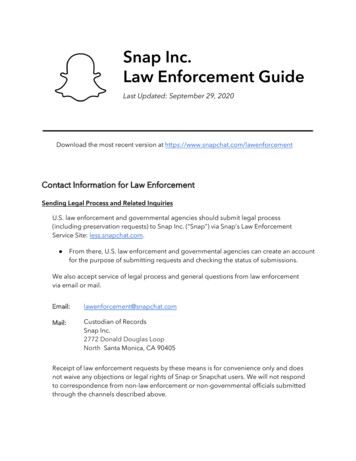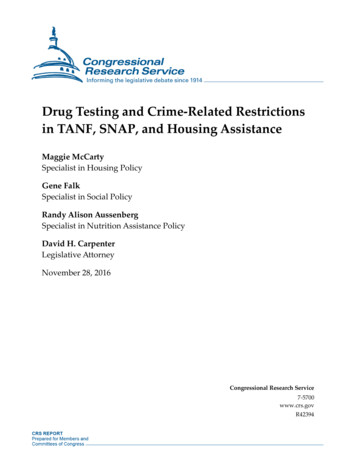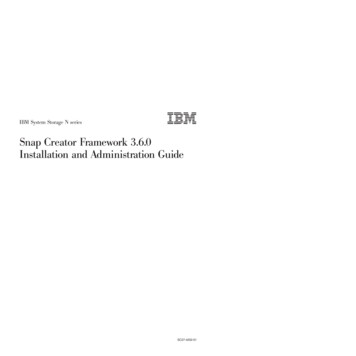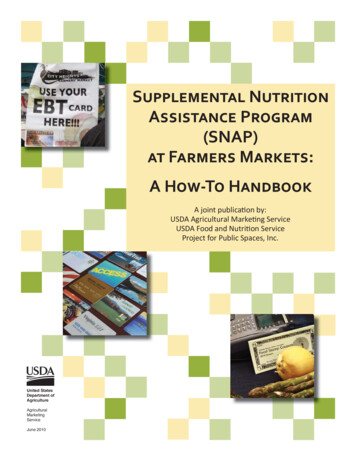
Transcription
SUPPLEMENTAL NUTRITIONASSISTANCE PROGRAM(SNAP)AT FARMERS MARKETS:A HOW-TO HANDBOOKA joint publication by:USDA Agricultural Marketing ServiceUSDA Food and Nutrition ServiceProject for Public Spaces, Inc.United StatesDepartment ofAgricultureAgriculturalMarketingServiceJune 2010
AgriculturalMarketingServicePreferred CitationWasserman, Wendy, Debra Tropp, Velma Lakins, Carolyn Foley, Marga DeNinno, Jezra Thompson, Nora Owens, and Kelly Williams. SupplementalNutrition Assistance Program (SNAP) at Farmers Markets: A How-To Handbook. U.S. Department of Agriculture, Agricultural Marketing Service, June2010. http://dx.doi.org/10.9752/MS039.06-2010 The U.S. Department of Agriculture (USDA) prohibits discrimination in all its programs and activities on the basis of race, color, national origin,age, disability, and where applicable, sex, marital status, familial status, parental status, religion, sexual orientation, genetic information, politicalbeliefs, reprisal, or because all or a part of an individual’s income is derived from any public assistance program. (Not all prohibited bases apply to allprograms.) Persons with disabilities who require alternative means for communication of program information (Braille, large print, audiotape, etc.)should contact USDA’s TARGET Center at (202) 720-2600 (voice and TDD). To file a complaint of discrimination write to USDA, Director, Office of CivilRights, 1400 Independence Avenue, S.W., Washington, D.C. 20250-9410 or call (800) 795-3272 (voice) or (202) 720-6382 (TDD). USDA is an equalopportunity provider and employer.
SUPPLEMENTAL NUTRITIONASSISTANCE PROGRAM(SNAP)AT FARMERS MARKETS:A HOW-TO HANDBOOKA joint publication by:USDA Agricultural Marketing ServiceWendy Wasserman, Debra Tropp, and Velma LakinsUSDA Food and Nutrition ServiceCarolyn Foley, Marga DeNinno, and Jezra ThompsonProject for Public Spaces, Inc.Nora Owens and Kelly WilliamsUnited StatesDepartment ofAgricultureAgriculturalMarketingServiceJune 2010i
ii
INTRODUCTIONThe Supplemental Nutrition Assistance Program (SNAP)(formerly the Food Stamp Program) is the Nation’s largestnutritional assistance program and the cornerstone ofFederal Government efforts to alleviate hunger in theUnited States and its territories. SNAP benefits arefunded by the United States Department of Agriculture’sFood and Nutrition Service (FNS). They are issued byindividual States and redeemable at any authorized FNSSNAP retailer, which includes an increasing number offarmers markets.wireless POS terminals, the technology can be difficult tomanage and promote at farmers markets.Operating an EBT machine requires an FNS license. FNSallows markets to obtain a single FNS license for all eligiblevendors at the market. SNAP benefits are redeemedusing one centrally located POS terminal; transactions areprocessed throughout the farmers markets using scrip(paper certificates, tokens, or receipts). SNAP customersredeem their benefits by swiping their EBT cards at thePOS terminal in exchange for scrip, which they can use tobuy eligible food products. This process is similar to onesometimes used for accepting credit and debit cards atfarmers markets. While it is possible for individual vendorsto have their own FNS license and POS terminal, scripprojects are the most common way for farmers markets toaccept SNAP benefits.SNAP benefits are accessed via an Electronic BenefitTransfer (EBT) card that is processed using electronicfunds transfer technology. EBT cards look and operatelike bank-issued debit cards. SNAP benefits are accessedby swiping the EBT card on a point-ofsale (POS) terminal at an FNSS SNAPretailer location and enteringga personal identificationnumber (PIN). FNSSNAP retailers can eitheruse EBT-only machines,which look like standardcommercial POS terminalsand are provided for freeby FNS, or supply theirown terminals. EBT-onlymachines require electricityand a phone line connectionn andaccept only EBT cards. Many FNS SNAPretailers choose to pay for commercial POS terminals thataccept EBT, debit, and credit cards on the same machine.This handbook is a how-to guide for accepting SNAPbenefits at farmers markets. Topics include:Electrical hookups and phone line connections are notavailable at many farmers market sites, preventing theuse of the free EBT-only machines. Even when marketmanagers and vendors are willing and able to invest in1 Why to accept SNAP benefits How to install EBT systems at farmers markets How to use scrip projects to accept SNAP benefits atfarmers markets How to become an FNS SNAP retailer What equipment is required to accept SNAP benefitsat farmers markets How to make SNAP EBT succeed at farmers markets A glossary and some tools and resources
Brief historyThe USDA began issuing commodity vouchers (stamps)between 1939 and 1943, in one of the first efforts by theFederal Government to supplement the diets of lowincome Americans by connecting supply with demand. TheFood Stamp Act of 1964 created the Food Stamp Program,which funded pilot projects to test whether a federallyfunded program could help low-income households obtaina healthier diet. The Food Stamp Act of 1977 reauthorizedthe Food Stamp Program and set national eligibilityrequirements. Although the program initially issued paperfood stamp coupons, the Personal Responsibility and WorkOpportunity Reconciliation Act of 1996 required all Statesto issue food stamp benefits via EBT. The switch fromcoupons to EBT was completed nationwide in 2004.The move from coupons to EBT cards was a step forwardin increasing program integrity, reducing fraud, andeliminating the stigma for using food stamps. In 2008,Congress renamed the program the SupplementalNutrition Assistance Program to more accurately describeit. Participation in SNAP is currently at a historic high. Asof December 2009, almost 39 million Americans (one ineight) were receiving SNAP benefits. SNAP redemptionsfor fiscal year (FY) 2009 were approximately 50 billion.11 USDA, Food and Nutrition Service, Supplemental Nutrition AssistanceProgram, Fiscal Year 2009, Benefit Redemption Division Annual Report2
PARTICIPATING IN SNAP AT A FARMERS MARKETstands, even though the number of farmers markets inthe United States exceeded 5,200 in that year.5 Therefore,there remains much room for growth in the ability offarmers markets to increase their share of the SNAPredemption pool by adopting EBT technology attheir facilities.What are the benefits of participating in SNAP?Adopting EBT technology to accept SNAP benefits canhelp markets tap into a larger customer base by providingan easy and convenient way for consumers to redeemSNAP benefits on eligible food items.2 For vendors sellingeligible food items, the potential for increased salesfrom SNAP redemptions can be substantial. Betweenfiscal year 2008 and 2009, for example, the total value ofSNAP redemptions at farmers markets and farm standsnearly doubled, from over 2 million to over 4 million.3Although the recent growth in SNAP redemptions atfarmers markets has been impressive, it is important torecognize that the amount of SNAP benefits redeemed atfarmers markets and farm stands in FY 2009 ( 4.33 million)still only represents less than one-hundredth of 1 percentof the total ( 50 billion).4 Of more than 193,000 retailersparticipating in SNAP in 2009, only one-half of 1 percent,or just over 900, were farmers markets or farmEBT technology also allows markets that normally acceptonly cash to accept bank-issued debit and credit cards.While it is possible to increase vendor sales via EBTsales alone, the ability to process debit and credit cards,along with EBT, stimulates a sharper increase in vendorrevenue, which can be used to offset EBT operating costs.However, when embarking on this process, it is essentialto understand all the fees involved in accepting debit andcredit cards, such as fees for connecting and disconnectingthe POS terminal; bank and routing fees; monthly servicefees (including those charged in the off season); and EBT,credit, and debit transaction fees.Case Study: Greenmarket, New York, NYGreenmarket, the largest network of producer-only farmers markets in New York City, has accepted SNAP benefitssince 2005 at several of its farmers markets. Working with a variety of partners at all levels of the government andcommunity, Greenmarket has been able to fund its SNAP project, reaching more potential customers. In 2006, itreceived a USDA Farmers Market Promotion Program (FMPP) grant to evaluate the implementation of wireless EBTterminals at the market and the impact on market sales. Greenmarket also partnered with the Human ResourcesAdministration, which administers SNAP for New York City, to promote the project. The organization collaboratedwith several community groups and organizations, including food stamp offices, faith-based organizations, soupkitchens, and food pantries, to help spread the word that SNAP is accepted at many of its farmers markets. Thismulti-level support helped Greenmarket fund its SNAP program and allowed Greenmarket to increase SNAP salesfrom 101,000 in 2008 to 251,000 in 2009.For more information, please visit: www.cenyc.org/greenmarket.2 For more details about eligible food items, see www.fns.usda.gov/snap/retailers/eligible.htm3 USDA, Food and Nutrition Service, Supplemental Nutrition AssistanceProgram, Fiscal Year 2009, Benefit Redemption Division Annual Report4 Ibid5 www.ams.usda.gov/AMSv1.0/WFMFarmersMarketGrowth3
What is involved in setting up SNAP EBT atfarmers markets?How are SNAP purchases made in farmers marketsthat operate a scrip project?Accepting SNAP benefits at farmers markets calls for awell-thought-out business plan, which considers not justthe initial set-up costs, but ongoing operating and laborcosts for administration and for promoting and marketingthe program. Time and resources will be spent developingthe infrastructure (equipment, staff time, and additionalaccounting procedures). Wireless POS terminals can costnearly 1,000 to install and program, and operation costscan run even more.6 Many expenses (monthly wirelessnetwork service, transaction fees, and labor) will exist forthe life of the program. It may take a few years for SNAPredemptions to justify programmatic costs, thus, it isimportant to have realistic expectations about how quicklySNAP and credit card sales will grow.Two types of scrip can be used: paper scrip/tokens orreceipts. Markets can either swipe the SNAP customer’sEBT card on a central POS terminal, or they can fill outa paper voucher to redeem SNAP benefits in exchangefor scrip/tokens or receipts. Regardless of the systememployed, the deposit is made directly into the market’sbank account within 2 business days after the purchasesare entered into the POS terminal. The market then followsits own procedures for reimbursing vendors.Case Study: Eastern Market, Detroit, MIIn 2007, Detroit’s Eastern Market began acceptingSNAP benefits by using wooden tokens. In thebeginning, customers redeemed SNAP benefitsfor the tokens at an EBT machine at one booth inthe market. Due to demand by both customersand vendors, a second booth was added. ByAugust 2009 over 137,000 in SNAP benefitswere redeemed at Eastern Market, and in January2010 SNAP sales topped 200,000. In September2009, in cooperation with the Fair Food Network,Eastern Market piloted a 7-week program to offeran additional 10 in spending power to SNAPcustomers using benefits at the market via theMichigan “Mo’ Buck” vouchers (Michigan’s SNAPcards). More than 1,000 customers used thisprogram during the limited time it was offered,yielding over 21,000 in SNAP sales at themarket in 7 weeks. There are plans to renew thematching program again in June 2010.How do farmers markets use EBT technology toaccept SNAP benefits?Implementing a scrip project is the most common way forfarmers markets to participate in SNAP because it allowsmultiple vendors at a market to accept SNAP benefitswithout having to obtain individual SNAP licenses andPOS terminals for each vendor. Instead, the farmersmarket gets one SNAP license and uses an alternate formof currency (paper scrip or tokens are the most common)to complete the transaction between individual vendorsand SNAP customers, using a single POS terminal. Scripcan also be used to accept bank-issued credit and debitcards when there is a single POS terminal in use. Vendorsprocess the scrip currency the same way—whether ornot the shopper is making an EBT or a debit/credit cardpurchase—which can help lessen the stigma sometimesassociated with using SNAP benefits. The market isresponsible for the design and cost of the scrip.For more information, please visit:www.detroiteasternmarket.com.6 Hahn, Marcia, “EBTs Bring More Revenue to Farmers Markets,”Farmers Markets Today, March/April 2008, p. 23.4
1. A SNAP customer swipes the EBT card at the centralPOS terminal and enters the PIN.2. The staff member records the transaction on a manualvoucher that the customer signs, as well as in themarket’s log book for bookkeeping.2. The staff person enters the amount of scrip or tokensrequested into the terminal.3. The next step depends on whether the market has anoffsite POS terminal:3. Once the transaction is approved, the SNAP customeris given a transaction receipt and scrip or tokens.a. If it does, the manual vouchers are keyed into theoffsite terminal for processing at the end of themarket day.Option 1 – Using scrip or tokens4. The SNAP customer then uses the scrip or tokensat any participating vendor’s stand to purchaseeligible items.b. If the market does not have a POS terminal, themanual vouchers are mailed to the State’s EBTcontractor. Markets generally have 15 days tomail in the vouchers. The direct deposit into themarket’s bank account occurs within 2 businessdays after the EBT contractor receives the vouchersin the mail.Option 2 – Using receipts1. A SNAP customer shops at a vendor’s stand andreceives a receipt from the vendor for food itemspurchased, and then leaves the purchased items withthe vendor.2. The SNAP customer goes to the central POS terminalwithout the purchased goods to swipe the EBT cardfor the amount on the vendor’s receipt and entersthe PIN.Key Contacts for EBT installation3. Once approval is granted, the manager gives thecustomer another transaction receipt to confirmpayment, which the customer brings back to thevendor to retrieve the purchased items. FNS is the USDA agency that administersSNAP and approves all retailers whoparticipate in the SNAP program.(www.fns.usda.gov/snap) FNS Field Offices are located in each Stateand are the primary points of contact for anyEBT- or SNAP-related questions, includingcompleting and submitting a SNAP retailerapplication. t.htm) State SNAP Offices manage SNAP at thelocal level and may be referred to as theSNAP or EBT office. These offices informparticipating vendors about changes and/ordirectives from FNS, and relay information toFNS about any changes reported by farmersmarkets (like change of location or contactinformation). More information about StateSNAP offices can be found at: www.fns.usda.gov/snap/ebt/fm.htm. A list of toll-free EBT customer servicenumbers is available at: al VouchersFarmers markets without a POS terminal, or that use anoffsite terminal, can employ manual vouchers. Manualvouchers are also used if a customer’s EBT card or the EBTsystem is not functioning. Manual vouchers can be usedwith either scrip, tokens, or receipts.1. The market staff calls a customer’s EBT card numberinto the retailer EBT customer service number fortransaction approval, placing a hold on the customer’sSNAP account for the amount of the transaction.5
BECOMING AN FNS SNAP RETAILERWhich farmers markets are eligible to participatein SNAP?How does a farmers market apply to become anFNS SNAP retailer?A farmers market is eligible to become an FNS SNAPretailer if the market sells eligible food products and meetat least one of two criteria, identified as criterion A andcriterion B.To become an FNS SNAP retailer, a farmers market appliesfor a license on behalf of participating vendors. Themarket is considered the sponsoring organization on theapplication. The leader of the sponsoring organization,often the chair of the market’s board of directors or themarket’s manager, is usually named as the “responsibleparty.” All retailers, including farmers markets, are legallyrequired to file a Social Security number at the time ofapplication. The primary purpose of collecting SocialSecurity numbers is to maintain program integrity andto discourage fraud. While the application may requestthe names of the board of directors, it is not necessaryfor all directors to submit their Social Security numbers.FNS will accept the name and Social Security number ofone member. All Social Security numbers are kept strictlyconfidential and are only collected to help prevent fraud.Criterion A – Offer on a continuous basis at least threedifferent varieties of food in each of the following fourstaple food groups, with perishable foods in at leasttwo categories, on a daily basis: Fruits and Vegetables(includes plants and seeds for growing fruits orvegetables); Breads and Grains; Dairy; and Meat,Poultry, and Fish.orCriterion B – Have at least 50 percent of total grossfarmers market retail sales in eligible staple food items(e.g., bread, flour, fruits, vegetables, beef, chicken, fish,etc.). Most farmers markets meet this requirement.Applications to become an FNS SNAP retailer may befound at: www.fns.usda.gov/snap/ebt/fm.htm. A paperapplication can also be requested from FNS by phone at:(877)-823-4369.For more information on FNS SNAP retailer eligibilityrequirements, please visit: htm.6
EBT-Only Machines If the farmers market will use an EBT-only terminal,the State’s EBT contractor provides a retaileragreement to be signed and returned by theresponsible party.What is the process for submitting anFNS application?Follow these steps to submit an FNS application:1. Complete the FNS SNAP application and providesupporting documents to FNS. Follow the links on theFNS Farmers Market Web site to find the FNS contactinformation for your State. t.htm)2. Determine which scrip system will be used at themarket: paper scrip, tokens, or receipts. FNS willgather this information when the application issubmitted. Once the EBT contractor receives the signedretailer agreement, the contractor will mail theEBT-only terminal to the farmers market within 2weeks with instructions on how to install it. If themarket needs additional assistance, the marketcan call the toll-free retailer customer servicenumber provided by the EBT contractor. On-siteassistance is also available upon request. Once the equipment is operational, the EBTcontractor processes EBT transactions free ofcharge and distributes funds directly into thefarmers market’s bank account. Any changes in banking information should bereported to the EBT contractor 2 weeks in advanceof the change. This notification is very important tocontinue the uninterrupted transfer of funds.3. Agree to comply with the FNS guidelines by signingand submitting the application.Applications to become an FNS SNAP retailer can take upto 45 days to process. Applications may be approved fasterif all required documents are filled out completely.What happens after the FNS applicationis approved? FNS will send a training manual and video to thefarmers market. Additional guidance is availableat: ng Guide.pdf. FNS notifies the State EBT contractor. (Each Statecontracts with an EBT contractor who is responsible forSNAP EBT services in that State.) The EBT contractor will contact the farmers market todetermine POS equipment needs.Commercial POS Equipment If the farmers market wishes to use a wirelessterminal, or to accept debit and credit cardsas well as EBT, a market representative mustenter into a contract or agreement with a ThirdParty Processor (TPP) and purchase or lease thePOS terminal.7 The State’s EBT contractor will help identify theTPP that can supply wireless POS terminalscapable of accepting debit and credit cards alongwith EBT cards. It can take up to 30 days to purchase and receivea wireless POS terminal. However, markets canbegin the process of obtaining a commercial POSterminal before the FNS application is approved. All costs associated with this option are themarket’s responsibility.
Will grants and fundraising opportunities helpcover some expenses?The most popular method of funding SNAP at a farmersmarket is through grants. Several grant opportunitiesare available, such as the USDA’s FMPP7(additional USDAfunding resources listed in Appendix D).7 State farmersmarket associations may also have some funding ideasand suggestions on how to implement the program. Somemarkets defray the operating costs of SNAP participationby modestly increasing their vendors’ stall fees. Vendorscan also share all or some of the costs of the initialequipment and supplies. Some States may offer fundingopportunities as well. States have the option to providefarmers markets free or subsidized wireless POS terminalsthat also accept credit and debit cards. The FederalGovernment will share administrative costs associatedwith the wireless terminals, but only for specific costsattributable to processing SNAP transactions.Case Study: Colorado FarmersMarket AssociationIn 2006, the Colorado Farmers Market Association(CFMA) was awarded an FMPP grant to educatefarmers market managers and market vendorsabout SNAP and EBT use at farmers markets. Thegrant allowed CFMA to purchase wireless EBTmachines for 21 markets across the State. CFMAalso coordinated with the State-identified EBTcontractor to provide training, technical support,and other resources to participating farmersmarkets and market managers.7 www.ams.usda.gov/FMPP8
Can farmers markets offer a bonus incentiveprogram to attract SNAP customers?Case Study: City Heights Open Air &Certified Farmers Market, San Diego, CAIn addition to marketing, education, and outreach efforts,some markets are turning to bonus incentive programs toincrease their SNAP customer base. SNAP bonus incentiveprograms provide bonus or matching funds for SNAPpurchases, usually by giving SNAP customers extra scripwhen they use their EBT card at the market. Incentiveslike this encourage first-time SNAP shoppers at farmersmarkets; experience has shown that many become regularcustomers. SNAP bonus incentive programs are fundedby nonprofit organizations, local governments, and privatefoundations. The Federal Government does not providefunding for these programs.The City Heights Open Air & Certified FarmersMarket opened in July 2008. It was the firstfarmers market in San Diego county to havean EBT machine that accepted SNAP. Themarket uses wooden tokens to process SNAPpurchases. In partnership with the WholesomeWave Foundation (a private foundation thatoffers programs to match dollar values of SNAPbenefits at farmers markets), the market offeredan additional 5 in “fresh fund dollars” toSNAP customers who spent more than 10of their SNAP benefits at the market. Thisincentive program proved so successful thatSNAP redemptions nearly tripled. In 2008,the City Heights Open Air & Certified FarmersMarket also received an FMPP grant toencourage the redemption of SNAP paymentsvia incentive programs.What are some good recordkeeping practices whenaccepting SNAP benefits?Markets that operate a scrip project should keep recordsof scrip sales. Appendix B includes sample recordkeepingforms. Farmers markets typically track: Amount spent on scrip by customers using each of thedifferent accepted payment types (EBT, debit, orcredit cards). Scrip returned and credited back to the customer’sEBT/debit/credit accounts. (SNAP customers cannotreceive change or cash back. All returns must becredited back onto the customer’s SNAP EBT account.) Scrip turned in for reimbursement by every vendor oneach market day. Monthly and yearly sales reports.FNS does not require any reporting for scrip projects.However, if markets have adopted a bonus incentiveprogram, such as offering matching dollars orsupplemental dollar coupons, the program’s sponsorsmay require an additional set of records to evaluate theincentive program. Markets must submit a copy of anyreports required by the incentive program’s sponsorsto FNS. FNS reserves the right to request additionalinformation as needed.9
PREPARING TO ACCEPT SNAP EBT CARDSMarket managers should also plan to make agreementswith vendors that delineate requirements for SNAPprogram participation before the beginning of the marketseason. The agreements should include:What is the process for designing and purchasingscrip and/or tokens?Paper scrip or tokens can be purchased from variousprinting and specialty item companies (see Appendix E fora list). Keep these factors in mind when choosing betweenpaper scrip or tokens. Although paper is less bulky tohandle than wooden or plastic tokens, it is more easilycounterfeited. Tokens are cumbersome and bulky in largequantities, but are not easy or cost-effective to counterfeit.When using paper scrip, select paper that cannot bephotocopied to prevent fraud. Serial numbers on scrip arestrongly advised.Are taxes charged on SNAP purchases?Some States have sales tax on all food purchases; however,SNAP purchases cannot be taxed regardless of State orlocal food tax rules. In States where food is taxed, marketvendors traditionally fold the tax into the listed price of thefood item. However, vendors must deduct the tax from thetotal price of an item purchased with SNAP benefits. EachState has different tax rates and, in some cases, they varyby counties within States. Check with the State’s farmersmarket association or other designated State agency aboutobtaining a relevant tax adjustment table that vendors canuse when adjusting for SNAP purchases. A list of food items that can and cannot be purchasedwith SNAP benefits. Clear explanation of the types of records needed toprocess reimbursement. Information about the reimbursement processand schedule. Recommended and required signage. Guidelines on any additional rules associated withSNAP purchases (i.e., not giving change or cash back,no taxes charged, etc.).A sample agreement can be found in Appendix C, and apreparatory checklist is in Appendix B.Are vendor training and agreements necessary toparticipate in SNAP?Neither vendor training nor vendor agreements arerequired by law, but it’s a good idea for market managersto institute agreements and offer training to vendorsparticipating in SNAP so they will know what to expectfrom the EBT system and what they will need to do toaccept SNAP benefits. At least one training meeting shouldhappen before the market’s opening day, giving vendors anopportunity to walk through every step of the process andbecome familiar with the signage and equipment and thescrip, tokens, or receipts. They will need to understand thereimbursement procedures and recordkeeping forms thatwill be used in conjunction with the EBT system.10
Printed material should include:How do farmers markets tell customers theyaccept SNAP EBT cards?1. Clear indication that the market accepts SNAPEBT cards.Anecdotal reports indicate that customers often cite“word of mouth” as the number one way they found outabout a market accepting SNAP benefits. Many marketsdevelop banners and signage with the SNAP and EBT logosadvertising that SNAP EBT cards are accepted at farmersmarkets. Vendors, especially those that are certified SNAPretailers, may also have their own signage. Some farmersmarkets may develop their own printed material orbrochures about the SNAP program. All printed materialsshould be clear, simple, and concise and should includethe SNAP logo according to the FNS guidelines, which areavailable at: www.fns.usda.gov/snap/roll-out/logo.pdf.2. Location of the EBT machines and whether they alsoaccept credit/debit cards.3. The market’s location and days and times of operation.4. The products available for SNAP customersto purchase.5. The State-specific name for SNAP EBT cards.Useful SNAP outreach and nutrition education materialsare also available online at the SNAP-Ed Connection:snap.nal.usda.gov.11
Case Study: Athens Farmers Market, Athens, OHThe Athens Farmers Market, which began accepting SNAP in 2007, is located in Ohio’s rural southeast corner.The market’s mission is to offer business opportunities to regional growers and producers and to provide aplace for the Athens community to buy fresh, local food. It has strived to be a welcoming place for people fromall socioeconomic backgrounds. The market formed a partnership with Athens County Job and Family Services,which provided funding for staffing and marketing and helped connect their SNAP clients with the market.Athens County Job and Family Services was also helpful in advising on the types of promotional materials andefforts that would work best for attracting new customers. SNAP clients received promotional postcards aboutSNAP at the market. In July 2008, the Athens Farmers Market offered 5 incentive coupons to SNAP customersto encourage them to shop at the market.For more information, please visit: www.athensfarmersmarket.org.How can community partnerships help publicizeEBT programs at farmers markets?What other resources are available to boost SNAPand EBT use at farmers markets?Farmers markets partner with a wide range of groups,including city, State, and Federal government agencies;groups focused on “buy local” initiatives; food pantries;hospitals and clinics; faith-based organizations; andsenior centers. Partners can help with promotion inmany ways—they can hand out fliers about the marketSNAP EBT program, host cooking demon
Transfer (EBT) card that is processed using electronic funds transfer technology. EBT cards look and operate like bank-issued debit cards. SNAP benefi ts are accessed by swiping the EBT card on a point-of-sale (POS) terminal at an FNS SNAP retailer locati on and entering a personal identi fi cati on number (PIN). FNS SNAP retailers can either
